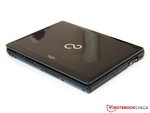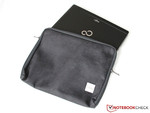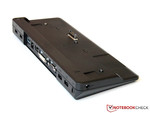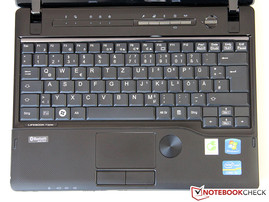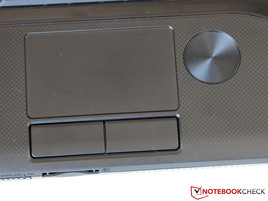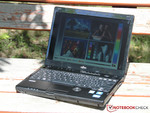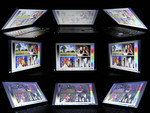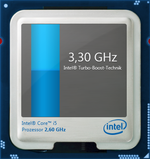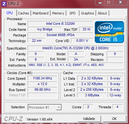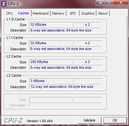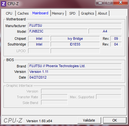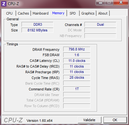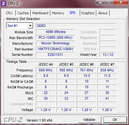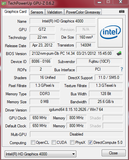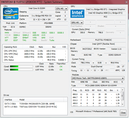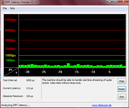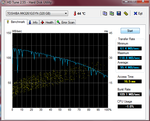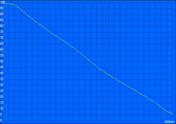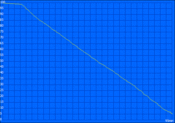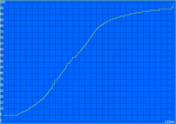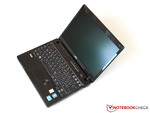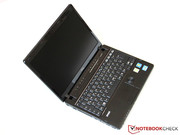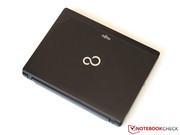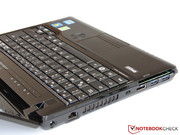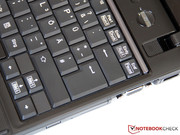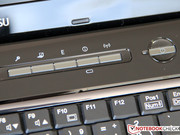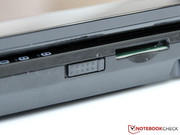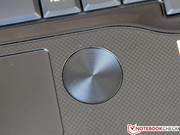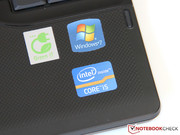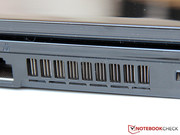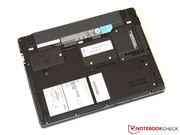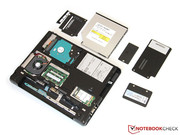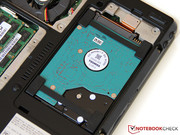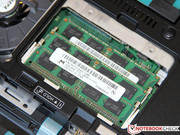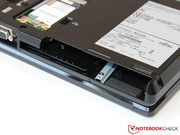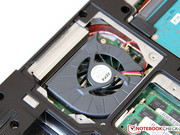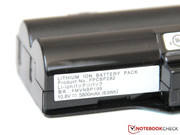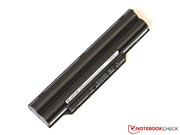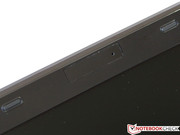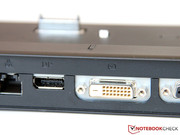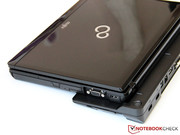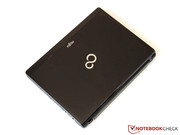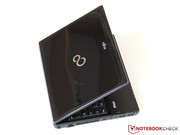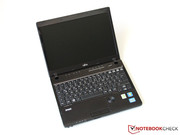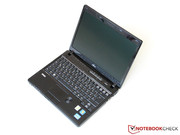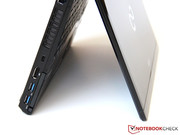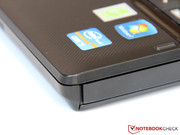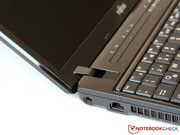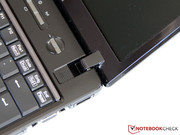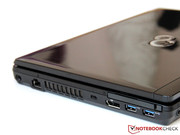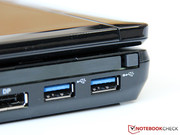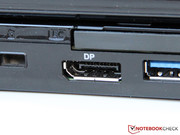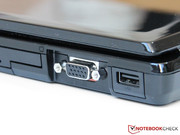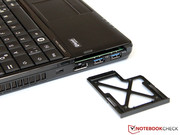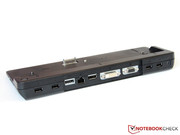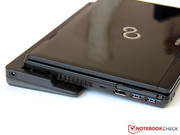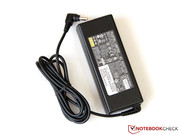Review Fujitsu Lifebook P772 Subnotebook

Powerful and well-equipped, yet compact and highly mobile - Fujitsu wants to meet just these claims with its Lifebook range. It is particularly targeted at well-heeled corporate customers and competes against other business laptops from HP, Dell and Lenovo.
Today's review is to take a closer look at the 12-inch Lifebook P772, which is the smallest model of the range. However, the laptop should not be underestimated because of its size. Our test model comes with a fast Intel Core i5-3320M from the Ivy Bridge generation. Models featuring the Core i7-3667U and two Core i3 models (2370M or 3110M) are also available. 8 GB of working memory and a 320 GB hard disk (SSDs optional) are to satisfy the buyer's storage needs. Moreover, a UMTS module is built-in and a few models can even be equipped with LTE.
The configuration we have been provided with is not yet available in retail, but will likely be priced between 1400 to 1600 Euro (~$1720 to ~$1966). HP's Elitebook 2560p (successor 2570p), Dell's Latitude E6220 (successor E6230) or Lenovo's ThinkPad X230 are sold for roughly the same price. These are serious contenders that the Lifebook P772 faces in the following review.
Case
Fujitsu replaces its older P771 with the P772, which uses an identically looking 12-inch case. Atypical for business notebooks, large parts of the surface are coated in black, high-gloss paint that we otherwise know from the consumer field. The chic look is unfortunately quickly tainted by inevitable dust layers, almost magically attracted by the glossy paint. Merely the wrist rest is matte and pleases with a pleasant-feeling texture.
The P772 is a rather big subnotebook with a height of 31 millimeters (1.2 inches). Thus it not only towers over every ultrabook, but clearly also the contenders. Despite its low weight of roughly 1.5 kilograms (3.3 pounds), it makes a rather sturdy impression in a direct comparison. Nevertheless, the Lifebook can still be called highly portable. We have to highlight the narrow display bezel (10 millimeters (0.4 inches) on the sides), which makes a particularly compact base surface of merely 28.2 x 21.5 centimeters (11.1 x 8.5 inches) possible.
While HP's Elitebook 2560p or Dell's Latitude E6220 flaunt with generous use of aluminum and other metals, simple plastic predominates on the P772, at least outside. This does not give the notebook an exceptionally high-end impression. Particularly since the stability is not quite as good as its contenders. We can easily dent the case around the keyboard by applying stronger pressure. However, the Lifebook should be sufficiently prepared for everyday wear and tear. The workmanship quality does not give much reason for complaint. All material transitions only exhibit marginal gaps and there are no sharp edges.
The display is held by two pleasantly tight hinges that require both hands for opening. Vibrations hardly let the lid teeter, but we would not have expected this from a small 12-incher anyway. The torsional stiffness is also quite decent due to the magnesium reinforcement, but cannot really compete with a full-body metal case. Overall, Fujitsu's Lifebook P772 secures itself a good total score, but is not a threat for the somewhat more solid models from Lenovo, Dell and particularly HP.
Connectivity
USB 3.0 moves into almost every modern laptop alongside the new chipsets from the Ivy Bridge generation. The P772 includes two of the fast ports, one of which features powered USB. It is located on the case's front left and is thus easy to reach. Another port using the older USB 2.0 standard is in the right rear area. Fujitsu even placed the display sockets, a DisplayPort and a VGA, on the notebooks left and right. An adapter is needed for connecting most TVs and some monitors because there is no corresponding HDMI out.
Gigabit LAN, an ExpressCard slot for 34 and 54 millimeter cards, 3.5 millimeter (1/8 inch) audio jacks for headphones and microphones as well as a SD card reader on the front complete the other interfaces. The Lifebook's modular bay is equipped with a DVD burner in our case. It can however easily be replaced with a BD burner, secondary battery, an additional hard disk or even a mini-projector ("Bay Projector").
The port replicator included for some models provides other interfaces. In addition to the listed ports, it adds 4 USB 2.0 ports, VGA, DVI, DisplayPort (cannot be used alongside DVI), GBit LAN and eSATA - so virtually everything that may be needed. The user can connect the laptop with the port replicator via the docking station on the bottom even during use. It features a dedicated power socket and a power switch. Thus, stationary peripherals or external monitors do not have to be connected / disconnected separately. Moreover, the slightly elevated rear increases typing comfort.
Communication
Besides the GBit LAN adapter (Intel 82579LM), the Lifebook of course features Intel's Centrino Advanced-N 6205 WLAN module. This upper range model supports both the 2.4 GHz and the 5 GHz band and transmits in the standards 802.11 a/b/g/n. Owing to the multi-stream technology (2x2), gross data rates of up to 300 MBit/s can be achieved theoretically. Moreover, the range and connection stability benefit from the two dual-band antennas. In addition to many features, such as Intel's Wireless Display, Bluetooth 4.0 for cable-free connecting of various input devices and smartphones with the laptop is also available.
So that Internet access on-the-go is possible, the P772 is available with either UMTS/HSPA+ (Sierra Wireless Gobi 3000) or LTE (Sierra Wireless MC7710 backward compatible). Our test model was limited to the UMTS module, which enables maximum download rates of 14.4 MBit/s in correspondingly developed mobile phone networks.
Unusual: A webcam is only optionally available for the P772. This is probably to address companies where camera phones and the like are partly prohibited for security reasons. However, if you do not want to forgo on video chats or snapshots, you can take delight in a high-resolution Full HD sensor. In return, a built-in microphone featuring flawless recording quality and good speech intelligibility belong to the standard equipment.
Security
Depending on the model, the Lifebook has a range of various security features. Anti-theft protection including Computrace, a TPM 1.2 module and a fingerprint scanner (not in the test model) are among these.
Accessories
The P772 comes with a surprising amount of accessories. In addition to the notebook, its battery and the 80 Watt power supply, we find the aforementioned port replicator, a dust cloth and a handy notebook sleeve. Various leaflets, such as a quick start guide and the compulsory warranty documents, are also part of the supplies. We merely miss a driver and a recovery DVD. They have to be created by the user.
Fujitsu opted for Windows 7 Professional 64-bit version as the operating system. The system is equipped with all required drivers and appears clean and well-arranged. Thus, the user is hardly bothered by undesired test versions and toolbars. However, the manufacturer has installed a few sensible helpers, for example the "Shock Sensor Utility" that protects the hard disk from potentially harmful bumps.
Maintenance
The Lifebook provides its user with many maintenance and upgrade possibilities, which can be performed via single covers on the bottom. It is for example possible to replace the working memory (maximum 2 x 8GB; 2 x 4GB ex-factory), the hard disk (2.5") or the WWAN module. Beyond that, accumulated dust can easily be removed from the fan and the heat sink. This requires a complete disassembly of the entire device in many other notebooks.
Warranty
Fujitsu grants a standard warranty of 2 years with bring-in service. The manufacturer's German online shop currently offers two optional packages. A three-year extension is possible for a mere 34 Euro (~$42) and a higher standard, 5 year warranty including on-site service for the next business day costs around 265 Euro (~$326).
Input Devices
Keyboard
The case's small width requires the corresponding compact keyboard featuring fairly small keys. Instead of the popular chiclet-style unit, Fujitsu opts for a conventional alternative that uses 18 x 18 millimeter (0.7 x 0.7 inch) keys that lessen to merely 12 x 12 millimeters (0.5 x 0.5 inches) toward the top. The layout hardly exhibits anything unusual. The black, slightly roughened plastic makes a quality impression that suits the notebook's business character well. A total of 5 special keys for facilitating use are found above the keyboard. For example, the notebook can be locked, Windows put to sleep or Wi-Fi networks managed by pressing a button.
You first have to get used to the unusually small keys/letters when typing. A slightly concave top helps hitting the keys accurately and achieving a high typing speed after a bit of familiarization. The stroke needs quite a bit of force and could also offer a crisper pressure point. Moreover, the keyboard yields in its center. The low noise design is a bonus point since typing is not noticed adversely even in very quiet surroundings.
Touchpad
Synaptic's touchpad is hardly bigger than in most netbooks with a size of only 4 x 6.8 centimeters (1.6 x 2.7 inches). The finger has to be relocated frequently when navigating from one corner of the screen to the other. In return, the smooth surface compensates that with good gliding traits regardless if the fingers are moist or dry. It enables an above-average accurate cursor navigation. Various multi-touch gestures, such as pinch-to-zoom, are supported, but they are a bit awkward due to the limited space.
There is an unusual, round recess on the mouse pad's right that takes over the scrolling function. It is possible to scroll up or down by using clockwise or counterclockwise circular movements - an interesting alternative to the usual input method that Fujitsu markets as "ScrollWheel". There are also two extremely crisp clicking mouse keys with a short stroke that imply good build quality.
Display
Screens featuring a home cinema-friendly 16:9 aspect ratio have become standard over the past few years. This is also true for the HP, Dell and Lenovo competition. Fujitsu takes another approach and relies on a slimmer aspect ratio of 16:10. Consequently, the resolution is also different: Rather than 1366x768, the 12.1 inch screen features a resolution of 1280x800 pixels. This can be seen as an advantage or disadvantage depending on the application. In both cases, the pixel density is a sufficiently fine 125 dpi.
In any case, the brightness seems worthy of improvement. We determined an average of just below 200 cd/m2 in maximum settings. That is clearly too little for a subnotebook even if the EliteBook 2560p and Latitude E6220 scored worse in former tests. In contrast, the ThinkPad X230 supplied an exemplary result of over 260 cd/m2. At least the Lifebook exhibits a subjectively homogeneous illumination and maintains its brightness on battery power.
| |||||||||||||||||||||||||
Brightness Distribution: 86 %
Center on Battery: 207 cd/m²
Contrast: 127:1 (Black: 1.67 cd/m²)
34.44% AdobeRGB 1998 (Argyll 3D)
43.47% sRGB (Argyll 3D)
32.8% Display P3 (Argyll 3D)
It is also the ThinkPad that marks the top in terms of black value and contrast. The Lifebook P772 can only dream of the brilliant picture quality of a high-end IPS screen. Instead, a thoroughly disappointing TN screen is installed. Black contents are always rendered a bit grayish due to a bright 1.67 cd/m2. The resulting contrast ratio of 127:1 is only low-end level. Unfortunately, such inferior screens are not the exception but the rule and include HP's EliteBook and Dell's Latitude.
Picture editing and graphic design on a subnotebook? Only very few Lifebook buyers will have any intentions in this regard. The P772 is not especially qualified for such applications anyway since the color spectrum cannot cover the vital standards like AdobeRGB or sRGB. Nevertheless, the notebook's color reproduction is absolutely sufficient for everyday use.
The screen's only average brightness prevents better results in outdoor use. Although the surface coating largely helps prevent annoying reflections, the screen cannot defy direct sunlight. A brightness of 250 to 300 cd/m2 or higher would be required for this, as for example found in the ThinkPad X230. The dark screens in the Latitude E6220 and EliteBook 2560p score even worse here.
Unstable viewing angles are another indicator for an inferior TN screen. The content distorts particularly in vertical deviations. The content respectively fades and dims when the screen is tilted upward or downward. The screen does not fare much better horizontally. Thus, the Lifebook is only suitable to an extent for viewing with several persons at the same time. A more expensive IPS screen would also bid basic benefits here.
We would recommend using an external monitor for home or office use. Resolutions up to 2560x1600 are possible via the DisplayPort. VGA and DVI support a maximum of 1920x1200 pixels. The analog VGA port produces excellent picture quality, which is almost on a par with the digital output's focus.
Performance
A few months after their release, the Ivy Bridge processors have firmly established themselves on the market and are available in an increasing number of laptops. The Core i5-3320M is the third fastest dual-core CPU of the range and is merely subordinate to the i5-3360M and i7-3520M.
As all mobile Core i5 processors, the 3320M supports both Hyper Threading (simultaneous processing of two threads per core) and Intel's Turbo Boost 2.0 which enables the processor to increase its default clock from 2.6 GHz to 3.3 GHz (2 cores: 3.1 GHz). The advanced 22 nanometer manufacturing - the Sandy Bridge precursor was still built-in 32 nanometers - enables especially low power consumption so that the i5-3320M hardly exploits its TDP of 35 Watts in practice. Owing to cutting-edge features, such as AES-NI or AVX, the CPU is well-equipped for future applications.
In addition to the processor cores, the PCIe interface and a memory controller, the chip also integrates a graphics unit that Intel calls HD Graphics 4000. The 16 shader units, the so-called Execution Units (EUs), clock with 650 to 1200 MHz (turbo) in the Core i5-3320M. This results in a graphics performance on a par with dedicated, low-end accelerators. Intel's HD 4000 supports both DirectX 11 API and the OpenCL GPGPU standard for the first time.
Our test model features a 320 GB hard disk and 8 GB of RAM that are distributed over two 4 GB DDR3-1600 modules from Micron. The memory interface consequently works in a dual-channel mode that is particularly beneficial for the graphics performance.
Processor
The Core i5-3320M achieves its maximum Turbo Boost of 3.3, respectively 3.1 GHz in both single and multi-thread benchmarking. This is reflected in correspondingly good benchmark results. As usual, we use the Cinebench series from Maxon for our test. It is based on the well-known Cinema 4D 3D graphics software. With 3.1 points, the i5-3320M surpasses its i5-2520M by approximately 7 percent in Cinebench R11.5, which will hardly be noticed in practical use though. The Core i7-3667U available for the Lifebook P772 should be about as fast. However, being a ULV model, its TDP is specified with only 17 Watts.
In view of the small 12-inch size, the notebook has remarkable performance reserves, which were reserved for much bigger DTR machines only a few years ago. The maximum performance is also available on-the-go because Fujitsu does not throttle the processor on battery power.
Storage Devices
According to the spec sheet, the Lifebook is offered with several HDDs (320 to 500 GB) and SSDs (128 to 256 GB). The P772 faces our test with a conventional hard disk from Toshiba (MK3261GSYN). It is a 320 GB model featuring a 16 MB cache and fast 7200 rpm. An effective storage capacity of roughly 280 GB remains after deducting the recovery partition. That should be enough for most users.
Although the hard disk lags far behind the performance of modern SSDs, both the average transfer rate of 95.4 MB/s and the access speed of 16.5 milliseconds (HDTune) are absolutely impressive. Booting is accomplished in only 35 seconds and the notebook wakes up from standby in less than 2 seconds.
System Performance
The P772 does not reach the uppermost performance ranks in our system benchmarks due to the lack of a SSD. Nevertheless, the accomplished 6747 points in PCMark Vantage and 2858 points in PCMark 7 are quite decent and on a par with the competition.
The user will rarely experience performance issues anyway. Even demanding programs will barely be a problem for the Lifebook. An even faster quad-core processor would hardly be suitable for the small case due to its higher power consumption - particularly since not every application benefits from the additional cores. We deem investing in a modern SSD to be more sensible as it not only improves responsiveness and booting times but also frequently contributes to a longer battery life. However, either the 2.5-inch HDD or the UMTS module would have to be removed before installing such a module. Unfortunately we could not check whether the mini PCIe slot will work with mSATA SSDs during our tests.
| PCMark Vantage Result | 6747 points | |
| PCMark 7 Score | 2858 points | |
Help | ||
Graphics Card
The HD Graphics 4000 is the HD Graphics 3000's heir that was found in the core processors of the Sandy Bridge series. The HD 4000 is still a graphics solution primarily made for Office and multimedia tasks despite a thorough revision and highly improved performance. The so-called multi-format codec engine (MFX) supports codecs like H.264, MPEG-2 or VC1 in resolutions up to 4K for this purpose. Besides decoding, video encoding and transcoding can be accelerated via QuickSync, which also unburdens the processor and reduces power consumption.
What does the 3D performance look like? As we previously examined in a comprehensive review, it is comparable with AMD's Radeon HD 6620G Llano APU in many cases. 703 points in 3DMark 11's performance preset correspond to a dedicated Radeon HD 7450M or GeForce GT 520MX. Current midrange accelerators, such as the GeForce GT 650M, are easily three times faster.
| 3DMark 03 Standard | 14871 points | |
| 3DMark 05 Standard | 10024 points | |
| 3DMark 06 Standard Score | 5929 points | |
| 3DMark Vantage P Result | 3817 points | |
| 3DMark 11 Performance | 703 points | |
Help | ||
Gaming Performance
The HD Graphics 4000 certainly does not promise unlimited gaming fun, but sufficient performance reserves for graphically undemanding tracks or low detail levels are available. You will find extensive benchmarks for Ivy Bridge's processor-integrated graphics unit in our database so that we only performed a few measurements to verify the already known performance at this point.
A consistently smooth game play was possible in 1024x768 pixels and minimum graphic quality in three of the four tested tracks. The player can even unhesitatingly enable the screen's native resolution of 1280x800 pixels in Anno 2070 and Dirt Showdown without having to expect annoying stutters. In return, the action RGP Deus Ex: Human Revolution needs somewhat higher frame rates, which is why we would refrain from increasing the settings here.
The particularly demanding game Alan Wake is too much for the HD 4000's capabilities even in lowest details. If you are interested in games like Battlefield 3, Ghost Recon: Future Soldier or The Secret World, you should also look for a gaming notebook with a much faster dedicated graphics card. Fujitsu's subnotebook is neither designed nor particularly suitable for such purposes.
| low | med. | high | ultra | |
|---|---|---|---|---|
| Deus Ex Human Revolution (2011) | 52.7 | 30.2 | ||
| Anno 2070 (2011) | 55.4 | 26.2 | ||
| Alan Wake (2012) | 11.5 | |||
| Dirt Showdown (2012) | 54.3 | 24.5 |
Emissions
System Noise
The Lifebook P772 is a quite silent partner that hardly attracts attention in most everyday situations. The fan frequently is completely disabled leaving only the hard disk's quiet whir of 30.9 dB(A) as a noise source when idling or performing basic Office tasks. The level increases up to 33.6 dB(A) when accessing the storage device and is accompanied by a subtle peeping noise. A slightly higher system load, for example Internet surfing with several tabs, results in a periodically roaring fan and approximately 35.5 dB(A).
It gets a lot louder in 3DMark 06 or comparable 3D applications. The noise level increases to 45.4 dB(A) after only a few minutes and even up to 46.6 dB(A) in our stress test. Since the fan spins with a very homogeneous and subjectively pleasant speed, we would call this level just still acceptable. However, the identically equipped ThinkPad X230 proves that it can be much quieter as it never exceeds 40 dB(A).
Noise level
| Idle |
| 30.9 / 30.9 / 35.5 dB(A) |
| HDD |
| 33.6 dB(A) |
| DVD |
| 37.1 / dB(A) |
| Load |
| 45.4 / 46.6 dB(A) |
 | ||
30 dB silent 40 dB(A) audible 50 dB(A) loud |
||
min: | ||
Temperature
At idle we measure a temperature of up to 39°C on the case's surface which is concentrated in the keyboard's center and thus in the user's work area. Nevertheless, the notebook can be used for surfing or typing on the lap without risking blisters or an overheating of the processor.
In return, we would recommend leaving the Lifebook on the desk during full load. The vent air gets extremely warm and heats up the surrounding plastic surfaces to 42°C and more. The cooling system of HP's EliteBook 2560p is more efficient and prevents such high temperatures.
A high temperature can perhaps be tolerated when it is counterbalanced by the corresponding high performance. Unfortunately, the processor throttles after only a few minutes and ultimately settles to 2.1 GHz at the end of our stress test (default clock: 2.6 GHz). Fujitsu seems to take a very defensive approach in the device's tuning because the temperature of approximately 84°C is still remote from critical ranges. At least the graphics unit keeps its default clock of 650 MHz stable. Since the 3DMark 11 benchmark performed immediately afterward did not exhibit a lower result, throttling should not be an issue in practical use - providing that the user ensures sufficient air circulation and frees the notebook from dust regularly.
(±) The maximum temperature on the upper side is 42.7 °C / 109 F, compared to the average of 35.9 °C / 97 F, ranging from 21.4 to 59 °C for the class Subnotebook.
(±) The bottom heats up to a maximum of 42 °C / 108 F, compared to the average of 39.3 °C / 103 F
(±) In idle usage, the average temperature for the upper side is 33.9 °C / 93 F, compared to the device average of 30.8 °C / 87 F.
(±) The palmrests and touchpad can get very hot to the touch with a maximum of 36.5 °C / 97.7 F.
(-) The average temperature of the palmrest area of similar devices was 28.2 °C / 82.8 F (-8.3 °C / -14.9 F).
Speakers
The sound quality of most Office laptops is generally quite modest, but we have to criticize the Lifebook's stereo speakers as below-average even in this competitive environment. The speakers do not render any basses and fail to drown out loud conversations even when the volume is turned up to max. Trebles sound both strident and low-detail so that we would recommend connecting external headphones or speakers in any case. This is possible via the 3.5 millimeter (1/8 inch) jack or DisplayPort (via adapter to HDMI).
Battery Life
Power Consumption
The Sandy Bridge CPUs already excelled with particularly sophisticated energy-saving features, which Ivy Bridge could hardly improve. Thus, it is not surprising that the Lifebook 772's idle power consumption of 7.2 to 11.3 Watts is practically on a par with last year's devices. Even the alternately available model featuring the Core i7-3667U processor will hardly be more energy-efficient, except in full load situations.
Our test device featuring the Core i5-3320M shows an average consumption of just below 50 Watts during load simulated via 3DMark 06. The power consumption is on a similar level at the beginning of our stress test, based on Prime95 and Furmark. However, the aforementioned throttling soon leads to a decrease of a bit over 40 Watts. This is comparatively high for a small subnotebook, but seems appropriate for the ascertained performance rates. Fujitsu gives the power supply unit a generous 80 Watts. However, models without the docking station include a smaller 65 Watt unit.
| Off / Standby | |
| Idle | |
| Load |
|
Key:
min: | |
Battery Runtime
A big 63 Wh battery sets out to make the P772 an endurance machine. Fujitsu promises a maximum runtime of 13 hours. It can be extended to 18 hours by swapping the DVD drive for the optional secondary battery (28 Wh).
That is the manufacturer's specification. But how long will the laptop really last? Even if we cannot quite confirm this promise due to "mere" 9 hours and 26 minutes in BatteryEater's Reader's test (energy-saving mode, minimum brightness, Wi-Fi module off), it is sufficient for keeping up with HP's EliteBook 2560p and Lenovo's ThinkPad X230.
This is also true for our Wi-Fi assessment (energy-saving mode, roughly 150 cd/m2), although with minor deductions. The measured backlog of 5 hours and 9 minutes on the named contenders is a bit bigger, but the Lifebook should survive a whole work day remote from the mains with occasional standby periods.
Finally, we tested the load runtime using BatteryEater's Classic test (high-performance, maximum brightness, Wi-Fi module on). The battery has to be recharged after a maximum of 95 minutes, which needs a good 2 hours.
Verdict
With its Lifebook P772, Fujitsu sets up a solid subnotebook to the greatest extent. Although our test reveals one or two shortcomings, the overall bundle is quite decent.
In any case, the black high-gloss case is exceptionally unusual and will likely meet with poor response in the business field. A matte case less prone for attracting grim, as seen in most contenders, would be far more viable for everyday use. We would also appreciate robust metal surfaces instead of plastic. Then again, the meticulous workmanship is absolutely appropriate for the device's pricing and gives no reason for complaint.
Owing to its fast processor, the Lifebook accomplishes remarkable performance rates, which could even be improved by using a SSD. Unfortunately, the laptop struggles a bit with the produced waste heat during extreme load and gets quite loud. The minor throttling we observed should however not be a problem in practical use.
There is also not much standing in the way of mobile use due to its compact size, built-in UMTS and long battery runtime. The matte screen is easily viewed even outdoors, as long as bright sunlight does not overtax the weak backlight. The included port replicator turns the P772 into a fully-equipped Office-HQ on the desk.
The question whether the Lifebook (currently only available with a deviating configuration) really is worth its price of 1500 Euro (~$1843) ultimately arises. If you do not need the optical drive, Lenovo's ThinkPad X230 featuring an excellent IPS screen is a particularly attractive alternative in our opinion. We also eagerly await the reviews of HP's EliteBook 2570p and Dell's Latitude E6230. The tide could turn again.




